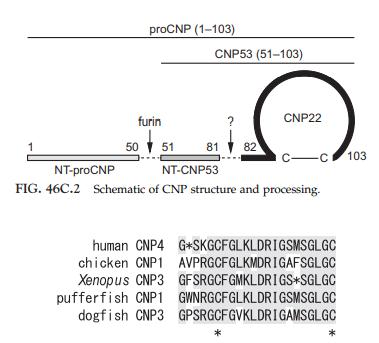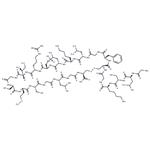The Mr of mature human CNP is 2199, and pI is about
9. It is soluble in water, acid, and 67% acetone, and partially soluble in 99% acetone. However, CNPs are not as
soluble in water as other NPs because of higher hydrophobicity. A CNP solution in water at >10-4M is stable
for more than a year at -20°C.
Gene, mRNA, and precursor
The human CNP gene (NPPC) is located on chromosome 2 (2q37.1), which is different from the loci of the
atrial natriuretic peptide (ANP) and B-type natriuretic
peptide (BNP) genes (NPPA and NPPB, 1p36). The
mouse CNP gene (Nppc) is on chromosome 1. In addition
to the mammalian CNP, all four types of CNP genes in
teleosts are composed of three exons and two introns,
although the exon-intron arrangement between CNP1/
2 and CNP3/4 is different. In elasmobranchs and cyclostomes, only one intron has been found in their nppc. The
human CNP mRNA is 1055 bp in length (381 bp coding
sequence). The human proCNP1–103 is cleaved into
CNP-53 (CNP51–103) and N-terminal (NT)-proCNP1–50
by the prohormone convertase furin.CNP-53 is further processed to give rise to the bioactive
mature form CNP-22 and inactive NT-CNP-53.
CNPs are highly expressed in the brains of tetrapods. In mammals, CNP transcripts are also identified in the
pituitary, cardiovascular system, endochondral bone, and reproductive systems.6 In teleosts, CNP1, CNP2, and
CNP4 are predominantly expressed in the brain, whereas
CNP3 is expressed in a variety of tissues including the
heart, pituitary, kidney, spleen, ovary, spinal cord, and
intestine. In elasmobranchs and cyclostomes, where
only a single CNP but no cardiac ANP/BNP/ventricular
natriuretic peptide (VNP) is found, CNP mRNA is
strongly expressed in both the brain and the heart. It
is noteworthy that CNP acts both as an endocrine hormone and as a paracrine/autocrine factor in these primitive vertebrates.
The human NPPC and mouse Nppc have a Y-box, a
CRE-like sequence, and a GC box in the proximal
50
-flanking region (the NF-κB recognition site is present
only in mouse Nppc). The putative transcription factors
are Sp-1, CREB, TSC22D1, and STK16. The regulation
of CNP release has been extensively studied using cultured endothelial cells, and CNP secretion is enhanced
by TGF-β, TNF-α, IL-1, ANP, and sheer stress, and suppressed by insulin and VEGF. Unlike ANP, CNPs are
not stored in large secretory granules.
The functional receptor for CNPs is the B-type NP
receptor (NPR-B or GC-B, Kd =30 pM). Similarly to the
receptor for ANP/BNP (NPR-A or GC-A), NPR-B is
coupled with guanylyl cyclase, which is involved in the cGMP-mediated intracellular signaling cascade, and
forms a homotetramer. In the medaka, CNP1, 2, and 4
bind to OlGC1 (a NPR-B homolog) while CNP3 prefers
OlGC2 (one of two NPR-A homologs). The human
NPR-B gene (NPR2) is located on chromosome 9
(9p13.3) and its protein contains 1047 aa residues with
an Mr of 117,022. NPR2 is widely expressed throughout
the body, including the brain, chondrocytes, lung, vascular smooth muscle, adrenal, kidney, ovary, and uterus. In the shark, npr2 is expressed in the rectal gland, a distinct salt-secreting organ. In the rainbow trout, the
expression of npr2 decreased upon transfer to seawater. CNPs also bind to the guanylyl cyclase-deficient receptor,
C-type NP receptor (NPR-C/NPR3), with high affinity
(Kd=48 pM).
C-ANF (an NP peptide with a truncated ring
sequence) is a selective agonist for NPR-C, and thus
enhances the paracrine and endocrine CNP actions on
NPR-B. Osteocrin containing the NP motif selectively
binds to the NPR-C, but not to the NPR-A or -B. HS-142-1 inhibits CNP binding to NPR-B, but not
NPR-C.
CNPs do not induce natriuresis at physiological concentrations. In mammals, the most recognized function
of CNP is the regulation of long bone growth. CNP targets chondrocytes to promote endochondral ossification.
CNP also has a vasodepressor effect in mammals, teleosts
(the eel and trout) and elasmobranchs, presumably
through its action on the vascular smooth muscle. In the medaka that lack npr1, CNP3 appears to be important for normal atrial development, as CNP3 knockdown
resulted in the hypertrophy of the atrium. Thus, CNP3
appears to take over the roles of ANP in this teleost. In the
shark, CNP3 stimulates the release of vasoactive intestinal peptide (VIP) from the nerve terminals within the rectal gland.
CNPs are ancient members of the natriuretic peptide family, which is characterized by the absence of C-terminal tail
extensions from the intramolecular ring. In mammals, CNP
is highly expressed in the brain, vascular endothelial cells, and
chondrocytes, and acts locally as a paracrine/autocrine
factor. CNP was isolated in 1990 from the killifish brain, and
shortly thereafter from the pig brain. Four distinct CNPs
(CNP1–4) were then discovered in 2003 from teleost
genome databases. Later, comparative genomic analyses
inferred that only CNP4 is retained in mammals, CNP1
and CNP3 in birds, CNP3 and CNP4 in amphibians,
CNP1–4 in most teleosts, CNP3 in elasmobranchs, and
CNP4 or CNP4-like NP in cyclostomes.
Natriuretic Peptide, C-Type (NPPC/ CNP) is a 22 amino acid peptide encoded by NPPC gene mapped to human chromosome 2q37.1. It belongs to the natriuretic peptide family.
C-type natriuretic peptide is produced in the hypothalamus, anterior pituitary, and most major endocrine glands. It has potent venodilatory and coronary vasodilatory effects, but minimal effects on renal function.
CNP has not been used as a diagnostic or therapeutic
tool. Several studies suggested potential uses of CNP,
such as for the treatment for growth disorders and as a
biomarker of growth plate activity.
Structure and conformation
Human proCNP consists of 103 aa residues with a bioactive mature CNP at the C-terminus. All
four types of CNPs consist of 22 aa residues except for
some teleost CNP4. Like other NPs, CNPs have a
17 aa intramolecular ring, but lack a C-terminal tail
sequence. CNPs are the most conserved NPs, although they contain different groups of peptides. The sequence identity
of mature CNP4 is >95% in mammals, except for unique
CNP in the little brown bat (Myotis lucifugus). CNP1 and
CNP3 are also well conserved (both >80% identity) in
each vertebrate class that possesses both peptides. In
contrast, CNP2 in teleosts is not so conserved. Although
major CNPs are of different types among vertebrate classes, mature sequences are highly conserved among these
CNPs, suggesting that CNPs have undergone
convergent evolution.




